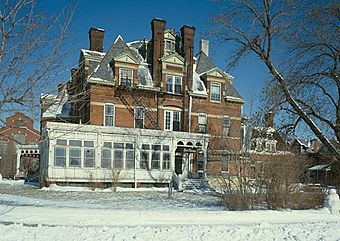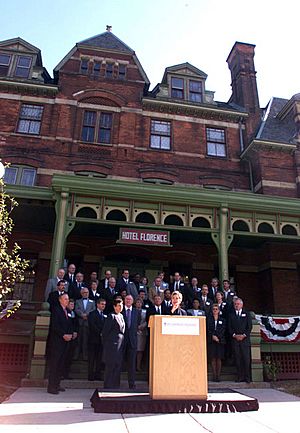Hotel Florence facts for kids
Quick facts for kids |
|
|
Hotel Florence
|
|
|
U.S. Historic district
Contributing property |
|

Hotel Florence
|
|
| Location | 11111 S. Forrestville Ave., Chicago, Illinois |
|---|---|
| Built | 1881 |
| Architect | Solon Spencer Beman |
| Architectural style | Gothic Revival |
| Part of | Pullman Historic District (ID69000054) |
| Added to NRHP | October 8, 1969 |
The Hotel Florence is an important old hotel located in the Pullman Historic District in Chicago, Illinois. It was built in 1881. The famous architect Solon Spencer Beman designed it. Since 1991, the Illinois Historic Preservation Agency has owned this historic building.
Contents
A New Way to Travel
The Rise of Traveling Salesmen
After the American Civil War, a new job became very popular: the traveling salesman. These "drummers," as they were called, traveled a lot. They often used trains to visit different towns and sell products. They needed places to sleep during their long trips.
George Pullman's Big Idea
To help these travelers, Chicago inventor George Pullman created the sleeping car. This was a special railroad car where seats could turn into beds. Pullman's sleeping cars were very successful. Railroad companies liked them because they were well-made and could be easily swapped with other Pullman cars. This made train travel much easier.
Building the Pullman Town and Hotel
In 1880, George Pullman started building a special town called Pullman, Illinois. He wanted to create a perfect community for his workers. The land was near the Illinois Central Railroad tracks and Lake Calumet. It was not yet part of Chicago, so Pullman could design and manage it himself.
The Pullman factories soon attracted many visitors. Salesmen from all over the world came to sell materials. These materials included iron, steel, and fabric needed to build the sleeping cars. George Pullman decided to build a hotel for these important visitors.
A Special Hotel for Special Guests
Architect Solon Spencer Beman designed the new Hotel Florence. It had 50 rooms and cost $100,000 to build. George Pullman named the hotel after his oldest daughter, Florence Pullman. The hotel's most luxurious room, the Pullman Suite, was for George Pullman and his family.
The hotel also offered fancy rooms for important railroad leaders. These leaders came to Pullman to do business with the company. The Hotel Florence opened its doors to guests on November 1, 1881. The hotel's restaurant was known for its delicious pork chops, which were added to the menu in 1902.
Changes Over Time
The Town Changes Hands
George Pullman had a lot of control over his company town. But things started to change in 1889. The city of Chicago took over Pullman and its surrounding areas. This meant Chicago's rules and laws now applied to the town.
Another big change happened in 1894. There was a difficult strike led by labor leader Eugene Debs. George Pullman passed away in 1897.
New Ways to Travel Emerge

After Pullman, Robert T. Lincoln took over the sleeping-car business. It continued to grow into the 1900s. The Hotel Florence even added a major new section, called the Annex, in the 1910s. However, this was also when the American passenger railroad industry reached its peak.
The automobile industry began to grow rapidly. More and more travelers and salesmen started driving cars instead of taking trains. By 1971, almost all American railroads stopped offering night train services. The sleeping-car business eventually ended.
Saving the Hotel Florence
In 1975, the Historic Pullman Foundation bought the hotel. They wanted to save it from being torn down. The Illinois Historic Preservation Agency took ownership in 1991. The Hotel Florence has been closed for renovations. The State of Illinois aimed to have it open by 2025, continuing its restoration work.

